Detailed Project Report For PMEGP Loan

Are you considering applying for a PMEGP (Prime Minister's Employment Generation Programme) loan but unsure about the detailed project report requirements? In this article, we will break down everything you need to know about creating a comprehensive and effective detailed project report to increase your chances of approval for a PMEGP loan.
Understanding the PMEGP Loan Process
Before diving into the details of the project report, it's essential to have a clear understanding of the PMEGP loan process. The PMEGP scheme is a credit-linked subsidy program aimed at generating employment opportunities in rural and urban areas of India. The program is jointly implemented by the Khadi and Village Industries Commission (KVIC) and the Ministry of MSME (Micro, Small & Medium Enterprises).
Importance of a Detailed Project Report
A detailed project report is a crucial component of your PMEGP loan application. It serves as a roadmap for your business idea, outlining the project's technical, financial, and operational aspects. A well-crafted project report not only helps in assessing the feasibility of your venture but also demonstrates your preparedness and commitment to the project.
Components of a Detailed Project Report
Creating a detailed project report can be a daunting task, but breaking it down into essential components can simplify the process. Here are the key elements to include in your project report:
- Executive Summary: Provide a brief overview of your business idea, including the project's objectives, scope, and expected outcomes.
- Market Analysis: Conduct thorough market research to understand the demand for your product or service, identify target customers, and analyze the competitive landscape.
- Technical Aspect: Describe the technological requirements of your project, including the production process, machinery, equipment, and infrastructure needed.
- Financial Projections: Prepare detailed financial projections, including estimates of project cost, revenue, expenses, and projected profits.
- Implementation Plan: Outline the step-by-step plan for implementing the project, including timelines, milestones, and key activities.
- Risk Analysis: Identify potential risks and challenges that may impact the success of your project and propose mitigation strategies.
- SWOT Analysis: Evaluate the project's strengths, weaknesses, opportunities, and threats to assess its overall feasibility and sustainability.
Tips for Writing an Effective Project Report
To ensure your project report stands out and impresses the loan authorities, follow these tips:
- Use clear and concise language to explain your business idea and project plan.
- Provide accurate and realistic financial projections based on thorough research and analysis.
- Include relevant supporting documents, such as market surveys, feasibility studies, and quotations from suppliers.
- Tailor your project report to the specific requirements of the PMEGP scheme and address any additional guidelines provided by the funding agency.
- Seek feedback from industry experts or consultants to strengthen your project report and address any potential shortcomings.
Conclusion
Crafting a detailed project report is a critical step in securing a PMEGP loan for your business venture. By following the guidelines outlined in this article and putting in the necessary effort to create a comprehensive and well-researched project report, you can improve your chances of approval and kickstart your entrepreneurial journey.
- Art
- Causes
- Crafts
- Dance
- Drinks
- Film
- Fitness
- Food
- Игры
- Gardening
- Health
- Главная
- Literature
- Music
- Networking
- Другое
- Party
- Religion
- Shopping
- Sports
- Theater
- Wellness
- IT, Cloud, Software and Technology


